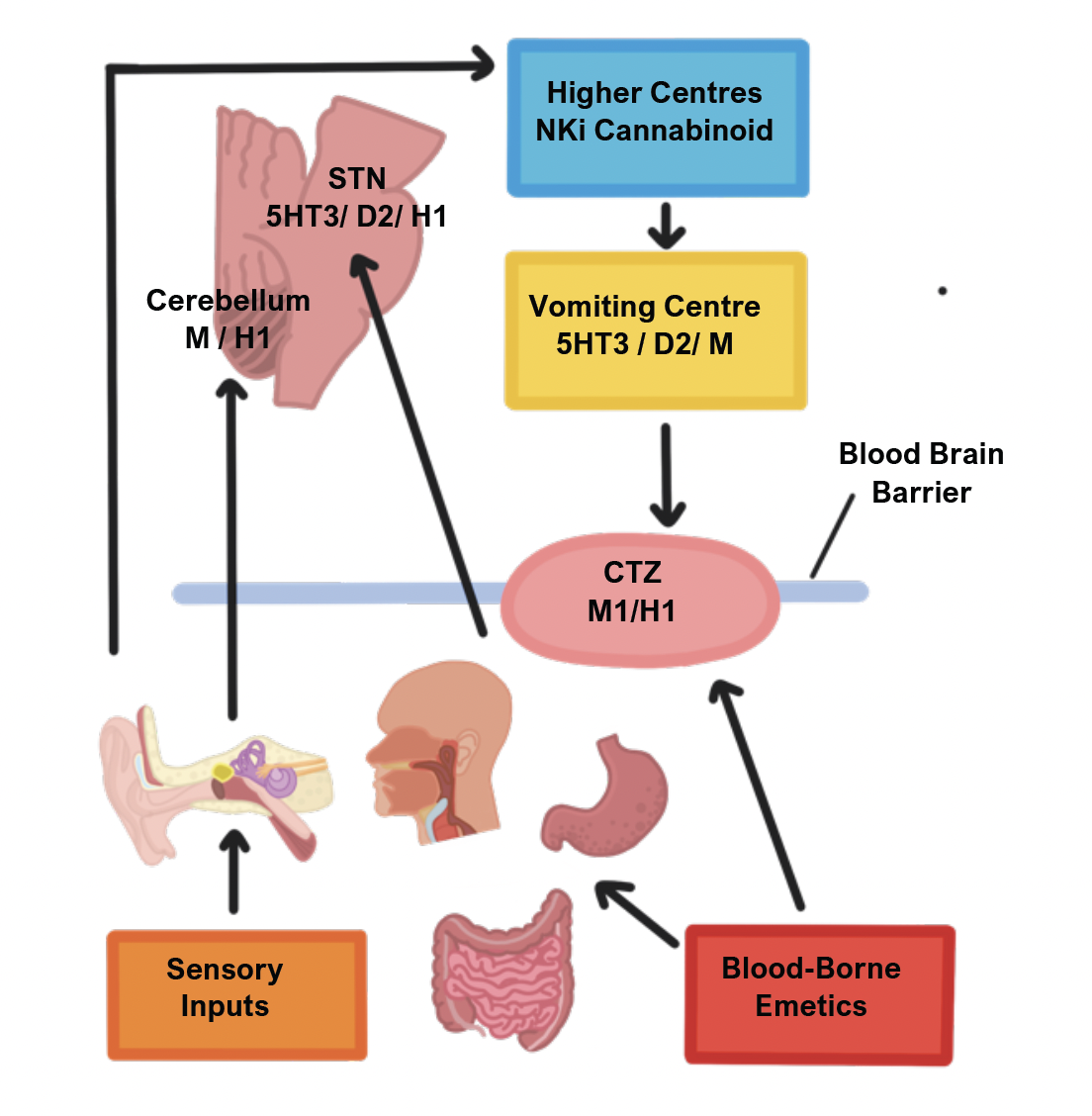Anti-Emetics
These drugs principally act by in inhibiting the chemoreceptor trigger zone, thereby blocking the activation of the vomiting centre in the medulla. Three of the most common first line anti-emetics are Metoclopramide + Cyclizine + Haloperidol.

D2 receptor antagonists
These block dopaminergic receptors in the CTZ which blocks activation of the vomiting centre.
Haloperidol
This is effective at stopping vomiting due to chemical reasons e.g. drugs (like opioids), hypercalcaemia.
Metoclopromide
This is used to stop all types of nausea except motion sickness
It also inhibits the dopamine break which usually inhibits the cholinergic neurones in gut, so aids bowel motility
It acts as a prokinetic gut agent, helping to increase lower oesophageal tone and it increases rate of food transit
Hence it is also used for reflux disease and helps treat gastroparesis secondary to diabetic neuropathy
Must be avoided in bowel obstruction with colic as it increases bowel contractions.
Domperidone
Unlike the drugs before, this does not cross the blood brain barrier and so it is safe to give in Parkinson’s disease.
Side effects
Metoclopramide and haloperidol cross the blood brain barrier and can cause extrapyramidal side effects, so their use is contraindicated in Parkinson’s disease (PD)
Domperidone does not cross the blood brain barrier, and so is safe in PD
H1 antagonists – Cyclizine, promethazine
These reduce histaminergic and cholinergic signalling, particularly in the vomiting centre of the vestibular apparatus.
Cyclizine is also used to treat nausea due to raised intracranial pressure as it directly inhibits the vomiting centre.
Cyclizine is a non-sedating drug, whereas promethazine is sedating.
Side effects
Anticholinergic/antihistaminergic effects, e.g., drowsiness, dry mouth, blurred vision
IV cyclizine is known to give patient’s a “high” so it is used with caution
5-HT3 antagonists – Ondansetron
This blocks 5-HT3 receptors in the CTZ, reducing stimulation of the vomiting centre.
It is used first-line to treat nausea due to chemotherapy, radiation-induced emesis, and post-operative nausea.
It is often combined with corticosteroids to produce an enhanced anti-mimetic effect.
Side effects
Constipation
Headache
AchR antagonists – Scopolamine (Hyoscine Hydrobromide)
This is a muscarinic antagonist which blocks M1 receptors in the vomiting centre and decreases the excitability of labyrinth receptors.
It is a very effective treatment for motion sickness.
There is another form of hyoscine called Hyoscine Butylbromide (Buscopan), not used as an anti-emetic:
This is used to reduce crampy abdominal pain, spasms and improves respiratory secretions at the end of life.
Side effects
Anti-muscarinic effects, e.g., drowsiness, dry mouth, and blurred vision
Levomapromazine
This is an antipsychotic which blocks multiple receptors e.g., D2, H1 and AchR.
It can therefore be used for multiple causes of nausea.
It also acts as a potent anxiolytic, so it is especially useful for young patients, as well as in palliative care medicine for nausea and agitation at the end of life.
Side effects
Sedation
Dexamethasone
This is a corticosteroid which is effective for prevention of nausea in patients who have had surgery, received epidural spinal opioids and chemotherapy.
It can potentiate the effect of ondansetron.
It is also used as an anti-emetic in people who have intracranial tumours.
Aprepitant
This is a neurokinin-1 antagonist which is used to treat emesis caused by chemotherapy, often in combination with 5-HT3 antagonists and steroids.
Side effects
Diarrhoea, also metabolized by CYP3A4 so influenced by other drugs
Some anti-emetics can be used in combination if they have complimentary actions:
i) Drugs which can be combined:
Cyclizine and Haloperidol (different mechanisms of action)
ii) Cannot combine:
Cyclizine (anti-kinetic) and Metoclopramide (pro-kinetic) as it gives opposing actions
Metoclopramide and Haloperidol (too much dopaminergic antagonism)
Disclaimer




